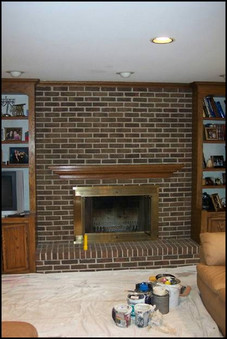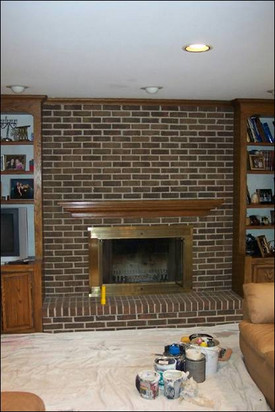Your dark brown brick focal wall may have looked au courant in the ’60s, but
 BEFORE. This washed-out fireplace has no pizazz. Faux painting and a refinished mantle subtly enhances the bricks, offering more depth and character. Photo courtesy of Brick Transformers. |
it’s likely out of date. The one-note grayish river stone and matching mortar on your fireplace surround probably stood out when the surrounding walls were white, but after you repainted the walls taupe, the stone now looks dingy.
Contrary to popular belief, homeowners with such dilemmas are not stuck with what they have nor is a coat of glossy white paint their only option. Manufacturers and artisans alike have been devising new products and techniques that allow brick or stone to shift from blah to beautiful.
Evaluate the Surface
Before considering a new look, it’s vital to assess the condition of the old surface. Common problems of old interior brick and stone include spalling and efflorescence. Spalling occurs when water gets inside the brick or stone and pushes salt toward the outside, causing the brick face to peel, flake or crumble. With efflorescence, the salt causes a white dust or greenish or brownish salt deposits.
“Usually [spalling and efflorescence are] caused by a moisture problem from a faulty roof or faulty chimney,” says Harry Brax of Brick Transformers in the Chicago area. “If there’s a moisture issue, refinishing isn’t going to prevent that from occurring.”
 AFTER. Previously, this washed-out fireplace had no pizazz. Faux painting and a refinished mantle now subtly enhances the bricks, offering more depth and character. Photo courtesy of Brick Transformers. |
To stop the moisture from seeping in, call a fireplace or masonry specialist or a contractor (or a restoration contractor if preserving the home’s historic nature is a concern) who can determine the cause and repair the problem. Take care of any necessary replacements or repointing before you move forward. If you need extensive repairs or want to rebuild, it will cost about $5 to $15 per square foot—more if you need special or historic brick—which doesn’t include demolition.
Next, closely examine the surface to determine what you’re working with. In most cases, you can telling just by looking if the brick or stone has been painted. You may need a professional to help you establish if it has been sealed or stained.
Create a Clean Slate
If your surface has been painted, you’ll likely want to strip the paint before trying to renew the brick or stone. This process isn’t easy. These materials are porous, and paint works its way into all the nooks and crannies. Sandblasting and pressure washing—often used on exterior brick and sometimes damaging to surfaces—are more difficult to try indoors. Instead, the pros use options like PeelAway, a product that is brushed on, overlaid with a special piece of paper, then stripped off—much like waxing a leg. You may need to apply the product several times before the surface is sufficiently free of paint.
After you’ve successfully removed the paint or if your surface wasn’t already painted, you’re now ready to clean. Use a sturdy brush or the rough side of a sponge along with brick cleaners like SoyClean, Renuit or others available at
 BEFORE. A brown brick fireplace surround darkens this room, causing it to blend in with the adjacent bookshelves. A lighter faux treatment lets the fireplace pop. Photo courtesy of Brick Transformers. |
building and hardware stores to clean. You also can try nontoxic household cleaners like Simple Green or even a mix of three-fourths white vinegar to one-fourth water.
After applying the cleanser and removing all the dirt, rinse the surface thoroughly using a sponge and water. Wait until the brick or stone is completely dry before you apply paint or stain.
Transform the Surface
In a few cases, simply cleaning years’ worth of dirt and flakes from your brick or stone will update its look. But, more than likely, after cleaning the surface you’ll want to paint or stain. Because brick and stone are porous, it’s important to choose a breathable paint, such as a latex or cement-based paint.
“Oil-based or alkyd paints are not good for brick,” says Brian Trimble, senior director of engineering for the Brick Industry Association. “They don’t bond well or react well with mortar joints. You can tell if you’ve used the wrong paint in about two months—it starts peeling. Moisture is meant to flow through brick.”
Some painters, designers and artists are faux painting brick to look like new—or like old, as the case may be. “What we do leaves the brick very natural-looking,” Brax says. “It just looks like a different type of brick and updates the fireplace.”
Why go to the trouble of a faux finish when you can just use a single coat of paint? “There’s no solid finish that will give you this type of (natural) look,”
 AFTER. A brown brick fireplace surround used to darken this room, causing it to blend in with the adjacent bookshelves. A lighter faux treatment now lets the fireplace pop. Photo courtesy of Brick Transformers. |
Brax says. “Oftentimes, people don’t want to paint their bricks, or they think it will devalue their home. I get calls from a lot of people who are turned off by painted brick in a house they’ve just bought.”
Specialists like Brax and others around the country have typically spent years perfecting mixes of stains, paints and glazes that will provide the right finish. Each brick is painted individually. Brax uses as many as 10 to14 different colors, applying them with brushes, rags, sponges, stamps, rags and rollers. “It’s the layering we do—the way that we apply it and the sequence that we apply it that gives it that depth and texture,” he says. If the mortar needs to be altered, the pros can do that, too.
Most of these experts say they can’t create a natural-looking faux finish on top of painted brick or stone. Some are working on perfecting a technique to allow them to do that. But for now, it’s too hard to achieve a really natural look over existing paint. You’ll have to try to remove it yourself first.
Homeowners can try to faux paint their own fireplace surrounds or brick/stone walls, but it’s not easy. “You have one fireplace and one chance,” Brax says. “If you overdo it, if you go too heavy with the materials, you’re going to clog up the pores.”
And that means starting over from the time-consuming—and not always completely effective—paint removal process.
Hiring a professional can cost about $10 to $12 per square foot, with variations based on individual conditions and aesthetic preferences.
Credit: Renovate Your World




























